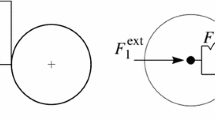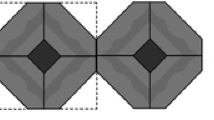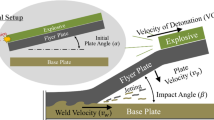Abstract
In this paper, an application of the reproducing kernel particle method (RKPM) is presented in plasticity behavior of pressure-sensitive material. The RKPM technique is implemented in large deformation analysis of powder compaction process. The RKPM shape function and its derivatives are constructed by imposing the consistency conditions. The essential boundary conditions are enforced by the use of the penalty approach. The support of the RKPM shape function covers the same set of particles during powder compaction, hence no instability is encountered in the large deformation computation. A double-surface plasticity model is developed in numerical simulation of pressure-sensitive material. The plasticity model includes a failure surface and an elliptical cap, which closes the open space between the failure surface and hydrostatic axis. The moving cap expands in the stress space according to a specified hardening rule. The cap model is presented within the framework of large deformation RKPM analysis in order to predict the non-uniform relative density distribution during powder die pressing. Numerical computations are performed to demonstrate the applicability of the algorithm in modeling of powder forming processes and the results are compared to those obtained from finite element simulation to demonstrate the accuracy of the proposed model.
Similar content being viewed by others
References
Li S, Liu WK (2002) Meshfree and particle methods and their applications. Appl Mech Rev 55:1–34
Belytschko T, Krongauz Y, Organ D, Fleming M, Krysl P(1996) Meshless methods: an overview and recent developments. Comput Meth Appl Mech Eng 139:3–47
Liu GR (2002) Meshfree methods-moving beyond the finite element method. CRC Press, Boca Raton
Gingold RA, MonaghanJJ (1977) Smoothed particle hydrodynamics: theory and application to non-spherical stars. Mon Not R Astron Soc 181:375–389
Lucy LB (1977). A numerical approach to the testing of the fission hypothesis. Astrophys J 82:1013–1024
Nayroles B, Touzot G, Villon P (1992) Generalizing the finite element method: diffuse approximation and diffuse elements. Comput Mech 10:307–318
Lancaster P, Salkauskas K (1981) Surfaces generated by moving least squares methods. Math Comput 37:141–158
Belytschko T, Lu YY, Gu L (1994) Element free Galerkin methods. Int J Numer Meth Eng 37:229–256
Belytschko T, Gu L, Lu YY (1994) Fracture and crack growth by element-free Galerkin methods. Model Simul Mater Sci Eng 2:519–534
Lu YY, Belytschko T, Gu L (1994) A new implementation of the element free Galerkin method. Comput Meth Appl Mech Eng 113:397–414
Perrone N, Kao R (1975) A general finite difference method for arbitrary meshes. Comput Struct 5:45–58
Liszka T, Orkisz J (1980) The finite difference method at arbitrary irregular grids and its application in applied mechanics. Comput Struct 11:83–95
Onate E, Idelsohn S, Zienkiewicz OC, Taylor RL (1996) A finite point method in computational mechanics applications to convective transport and fluid flow. Int J Numer Meth Eng 39:3839–3866
Atluri SN, Zhu T (1998) A new meshless local Petrov–Galerkin (MLPG) approach in computational mechanics. Comput Mech 22:117–127
Atluri SN, Kim HG, Cho JY (1999) A critical assessment of the truly meshless local Petrov-Galerkin (MLPG), and local boundary integral equation (LBIE) methods. Comput Mech 24:348–372
Liu GR, Gu YT (2001) A point interpolation method for two-dimensional solids. Int J Numer Meth Eng 50:937–951
Liu WK, Jun S, Zhang YF (1995) Reproducing kernel particle methods. Int J Numer Meth Fluids 20:1081–1106
Liu WK, Chen Y, Chang CT, Belytschko T (1996) Advances in multiple scale kernel particle methods. Comput Mech 18:73–111
Chen JS, Pan C, Wu CT, Liu WK (1996) Reproducing kernel particle methods for large deformation analysis of non-linear structures. Comput Meth Appl Mech Eng 139:195–227
Liew KM, Ng TY, Wu YC (2002) Meshfree method for large deformation analysis-a reproducing kernel particle approach. Engng Struct 24:543–551
Li S, Liu WK (2004) meshfree particle methods. Springer Berlin Heidel berg Newyork
Liu GR, Tu ZH (2002) An adaptive procedure based on background cells for meshless methods. Comput Meth Appl Mech Eng 191:1923–1943
Belytschko T, Krongauz Y, Fleming M, Organ D, Liu WK (1996) Smoothing and accelerated computations in the element-free Galerkin method. Int J Comput Appl Math 74:111–126
Krongauz Y, Belytschko T (1996) Enforcement of essential boundary conditions in meshless approximations using finite elements. Comput Meth Appl Mech Eng 131:133–145
Lu YY, Belytschko T, Tabbara M (1995) Element-free Galerkin method for wave propagation and dynamic fracture. Comput Meth Appl Mech Eng 126:131–153
Gunther F, Liu WK (1998) Implementation of boundary conditions for meshless methods. Comput Meth Appl Mech Engrg 163:205–230
Belytschko T, Tabbara M (1996) Dynamic fracture using element-free Galerkin methods. Int J Numer Meth Eng 39:923–938
Wagner GJ, Liu WK (2000) Application of essential boundary conditions in meshfree methods: a corrected collocation method. Int J Numer Meth Eng 47:1367–1379
Zhu T, Atluri SN (1998) A modified collocation method and a penalty formulation for enforcing the essential boundary conditions in the element free Galerkin method. Comput Mech 21:211–222
Drucker DC, Gibson RE, Henkel DJ (1957) Soil mechanics and work hardening theories of plasticity. Trans ASCE 122:338–346
Watson TJ, Wert JA (1993) On the development of constitutive relations for metallic powders. Metallurgical Trans 24:1993–2071
Brown S, Abou-Chedid G (1994) Yield behavior of metal powder assemblages. J Mech Phys Solids 42:383–398
Aydin I, Briscoe BJ, Sanliturk KY (1996) The internal form of compacted ceramic components. A comparison of a finite element modeling with experiment. Powder Tech. 89:239–254
Khoei AR, Lewis RW (1998) Finite element simulation for dynamic large elasto-plastic deformation in metal powder forming. Finite Elem. Anal. Des 30:335–352
Khoei AR, Lewis RW (1999) Adaptive finite element remeshing in a large deformation analysis of metal powder forming. Int J Numer Meth Eng 45:801–820
Brandt J, Nilsson L (1999) A constitutive model for compaction of granular media, with account for deformation induced anisotropy. Mech Cohes Frict Mater 4:391–418
Gu C, Kim M, Anand L (2001) Constitutive equations for metal powders: application to powder forming processes. Int J Plasticity 17:147–209
Lewis RW, Khoei AR (2001) A plasticity model for metal powder forming processes. Int J Plasticity 17:1659–1692
Khoei AR, Azami AR (2005) A single cone-cap plasticity with an isotropic hardening rule for powder materials. Int J Mech Sci 47:94–109
DiMaggio FL, Sandler IS (1971) Material models for granular soils. J Engrg Mech Div ASCE 97:935–950
Sandler IS, Baron ML (1979) Recent developments in the constitutive modelling of geological materials. In: Wittke W(eds). Proceedings 3rd internations conference Numerical Methods geomechanics, Aachen, Germany. Balkema Press Rotterdam, pp. 363–376
Simo JC, Ju JW, Pister KS, Taylor RL (1988) An assessment of the cap model: consistent return algorithms and rate-dependent extensions. J Eng Mech Div ASCE 114:191–218
Hofstetter G, Simo JC, Taylor RL (1993) A modified cap model: closest point solution algorithms. Comput Struct 46:203–214
Sandler IS, Rubin D (1979) An algorithm and a modular subroutine for the cap model. Int J Numer Anal Methods Geomech 3:173–186
Nelson I, Baladi GY (1977) Outrunning ground shock computed with different models. J Engrg Mech Div ASCE 103:303–377
Khoei AR, Azami AR, Haeri SM (2004) Implementation of plasticity based models in dynamic analysis of earth and rockfill dams; a comparison of Pastor-Zienkiewicz and cap models. Comput Geotechnics 31:385–410
Owen DRJ, Hinton E (1980) Finite elements in plasticity: theory and practice. Pineridge Press, Swansea
Gao XW, Davies TG (2002) Boundary element programming in mechanics. Cambridge University Press, Cambridge
Khoei AR (2005) Computational plasticity in powder forming processes, Elsevier
Doremus P, Geindreau C, Martin A, Debove L, Lecot R, Dao M (1995) High pressure triaxial cell for metal powder Powder Metal 38:284–287
Khoei AR (2002) Numerical simulation of powder compaction processes using an inelastic finite element analysis. Mater Des 23:523–529
Lewis RW, Khoei AR (1998) Numerical modelling of large deformation in metal powder forming. Comput Meth Appl Mech Eng 159:291–328
Gethin DT, Lewis RW (1994) Finite element modeling of powder compaction and its experimental validation. Powder metallurgy World congress, paris:689–692
Rodriguez-Ferran A, Perez-Foguet A, Huerta A (2002) Arbitrary Lagrangian–Eulerian (ALE) formulation for hyperelastoplasticity. Int J Numer Meth Eng 53:1831–1851
Author information
Authors and Affiliations
Corresponding author
Rights and permissions
About this article
Cite this article
Khoei, A.R., Samimi, M. & Azami, A.R. Reproducing Kernel Particle Method in Plasticity of Pressure-Sensitive Material with Reference to Powder Forming Process. Comput Mech 39, 247–270 (2007). https://doi.org/10.1007/s00466-005-0022-9
Received:
Accepted:
Published:
Issue Date:
DOI: https://doi.org/10.1007/s00466-005-0022-9




